9.2: Geothermal Electricity Generation
- Page ID
- 85147
\( \newcommand{\vecs}[1]{\overset { \scriptstyle \rightharpoonup} {\mathbf{#1}} } \)
\( \newcommand{\vecd}[1]{\overset{-\!-\!\rightharpoonup}{\vphantom{a}\smash {#1}}} \)
\( \newcommand{\id}{\mathrm{id}}\) \( \newcommand{\Span}{\mathrm{span}}\)
( \newcommand{\kernel}{\mathrm{null}\,}\) \( \newcommand{\range}{\mathrm{range}\,}\)
\( \newcommand{\RealPart}{\mathrm{Re}}\) \( \newcommand{\ImaginaryPart}{\mathrm{Im}}\)
\( \newcommand{\Argument}{\mathrm{Arg}}\) \( \newcommand{\norm}[1]{\| #1 \|}\)
\( \newcommand{\inner}[2]{\langle #1, #2 \rangle}\)
\( \newcommand{\Span}{\mathrm{span}}\)
\( \newcommand{\id}{\mathrm{id}}\)
\( \newcommand{\Span}{\mathrm{span}}\)
\( \newcommand{\kernel}{\mathrm{null}\,}\)
\( \newcommand{\range}{\mathrm{range}\,}\)
\( \newcommand{\RealPart}{\mathrm{Re}}\)
\( \newcommand{\ImaginaryPart}{\mathrm{Im}}\)
\( \newcommand{\Argument}{\mathrm{Arg}}\)
\( \newcommand{\norm}[1]{\| #1 \|}\)
\( \newcommand{\inner}[2]{\langle #1, #2 \rangle}\)
\( \newcommand{\Span}{\mathrm{span}}\) \( \newcommand{\AA}{\unicode[.8,0]{x212B}}\)
\( \newcommand{\vectorA}[1]{\vec{#1}} % arrow\)
\( \newcommand{\vectorAt}[1]{\vec{\text{#1}}} % arrow\)
\( \newcommand{\vectorB}[1]{\overset { \scriptstyle \rightharpoonup} {\mathbf{#1}} } \)
\( \newcommand{\vectorC}[1]{\textbf{#1}} \)
\( \newcommand{\vectorD}[1]{\overrightarrow{#1}} \)
\( \newcommand{\vectorDt}[1]{\overrightarrow{\text{#1}}} \)
\( \newcommand{\vectE}[1]{\overset{-\!-\!\rightharpoonup}{\vphantom{a}\smash{\mathbf {#1}}}} \)
\( \newcommand{\vecs}[1]{\overset { \scriptstyle \rightharpoonup} {\mathbf{#1}} } \)
\( \newcommand{\vecd}[1]{\overset{-\!-\!\rightharpoonup}{\vphantom{a}\smash {#1}}} \)
\(\newcommand{\avec}{\mathbf a}\) \(\newcommand{\bvec}{\mathbf b}\) \(\newcommand{\cvec}{\mathbf c}\) \(\newcommand{\dvec}{\mathbf d}\) \(\newcommand{\dtil}{\widetilde{\mathbf d}}\) \(\newcommand{\evec}{\mathbf e}\) \(\newcommand{\fvec}{\mathbf f}\) \(\newcommand{\nvec}{\mathbf n}\) \(\newcommand{\pvec}{\mathbf p}\) \(\newcommand{\qvec}{\mathbf q}\) \(\newcommand{\svec}{\mathbf s}\) \(\newcommand{\tvec}{\mathbf t}\) \(\newcommand{\uvec}{\mathbf u}\) \(\newcommand{\vvec}{\mathbf v}\) \(\newcommand{\wvec}{\mathbf w}\) \(\newcommand{\xvec}{\mathbf x}\) \(\newcommand{\yvec}{\mathbf y}\) \(\newcommand{\zvec}{\mathbf z}\) \(\newcommand{\rvec}{\mathbf r}\) \(\newcommand{\mvec}{\mathbf m}\) \(\newcommand{\zerovec}{\mathbf 0}\) \(\newcommand{\onevec}{\mathbf 1}\) \(\newcommand{\real}{\mathbb R}\) \(\newcommand{\twovec}[2]{\left[\begin{array}{r}#1 \\ #2 \end{array}\right]}\) \(\newcommand{\ctwovec}[2]{\left[\begin{array}{c}#1 \\ #2 \end{array}\right]}\) \(\newcommand{\threevec}[3]{\left[\begin{array}{r}#1 \\ #2 \\ #3 \end{array}\right]}\) \(\newcommand{\cthreevec}[3]{\left[\begin{array}{c}#1 \\ #2 \\ #3 \end{array}\right]}\) \(\newcommand{\fourvec}[4]{\left[\begin{array}{r}#1 \\ #2 \\ #3 \\ #4 \end{array}\right]}\) \(\newcommand{\cfourvec}[4]{\left[\begin{array}{c}#1 \\ #2 \\ #3 \\ #4 \end{array}\right]}\) \(\newcommand{\fivevec}[5]{\left[\begin{array}{r}#1 \\ #2 \\ #3 \\ #4 \\ #5 \\ \end{array}\right]}\) \(\newcommand{\cfivevec}[5]{\left[\begin{array}{c}#1 \\ #2 \\ #3 \\ #4 \\ #5 \\ \end{array}\right]}\) \(\newcommand{\mattwo}[4]{\left[\begin{array}{rr}#1 \amp #2 \\ #3 \amp #4 \\ \end{array}\right]}\) \(\newcommand{\laspan}[1]{\text{Span}\{#1\}}\) \(\newcommand{\bcal}{\cal B}\) \(\newcommand{\ccal}{\cal C}\) \(\newcommand{\scal}{\cal S}\) \(\newcommand{\wcal}{\cal W}\) \(\newcommand{\ecal}{\cal E}\) \(\newcommand{\coords}[2]{\left\{#1\right\}_{#2}}\) \(\newcommand{\gray}[1]{\color{gray}{#1}}\) \(\newcommand{\lgray}[1]{\color{lightgray}{#1}}\) \(\newcommand{\rank}{\operatorname{rank}}\) \(\newcommand{\row}{\text{Row}}\) \(\newcommand{\col}{\text{Col}}\) \(\renewcommand{\row}{\text{Row}}\) \(\newcommand{\nul}{\text{Nul}}\) \(\newcommand{\var}{\text{Var}}\) \(\newcommand{\corr}{\text{corr}}\) \(\newcommand{\len}[1]{\left|#1\right|}\) \(\newcommand{\bbar}{\overline{\bvec}}\) \(\newcommand{\bhat}{\widehat{\bvec}}\) \(\newcommand{\bperp}{\bvec^\perp}\) \(\newcommand{\xhat}{\widehat{\xvec}}\) \(\newcommand{\vhat}{\widehat{\vvec}}\) \(\newcommand{\uhat}{\widehat{\uvec}}\) \(\newcommand{\what}{\widehat{\wvec}}\) \(\newcommand{\Sighat}{\widehat{\Sigma}}\) \(\newcommand{\lt}{<}\) \(\newcommand{\gt}{>}\) \(\newcommand{\amp}{&}\) \(\definecolor{fillinmathshade}{gray}{0.9}\)Geothermal heat sometimes flows “all by itself” from underground caverns, as hot water in hot springs and geysers, or even as dry steam (the very first geothermal electric generator in the world was built in 1904 in Larderello, Italy, on a dry steam source that had been active since the ancient Roman times). More often, to get access to geothermal resources one has to drill wells – in areas with high geothermal activity they may not need to be very deep. But it is possible to access geothermal heat at almost any site of the globe, even if it is located far away from tectonic plate boundaries or other geothermal hot spots. If one digs a well or a shaft, the temperature of the surrounding rocks increases at a rate of 25-30◦ per kilometer – it’s referred to as the geothermal gradient. So, in order to “produce” hot water at boiling temperature, it may be enough to drill a well of 3-4 km depth and to pump water from it – if it happens to be down there. Or, if there is no water, one can drill two parallel wells and pump cold water from the surface down through one of them, and after it is heated, to recover it through the other well.
In order to generate electricity in a geothermal power plant, three “com-ponents” are needed:
- Heat – an underground geothermal “heat reservoir” is needed, with the property of “self-renewability” (meaning that if thermal energy were extracted from it, the loss would be supplemented at the same rate by heat influx from surrounding hot rocks).
- Fluid – sufficient fluid (water) must exist naturally in the reservoir, because only hot water or steam can act as the “carrier” of the thermal energy extracted from the reservoir through a “production well”. But if there in not enough water naturally occurring in the reservoir, extra water can be pumped into it through an additional “injection well”.
- Permeability – the water must be able to come into contact with the hot rocks, so that natural fractures must exist in the reservoir, or they have to be artificially created (e.g., in a similar way as “fracking” is performed in natural gas mining).
Depending on the temperature and the pressure in the reservoir, the thermal energy may be delivered to the surface either as dry steam or as hot water. Steam is convenient in that it may be directly sent to a turbine, as shown schematically in Fig. \(\PageIndex{1}\).

The dry steam technology was used in the aforementioned world’s first geothermal power plant at Larderello, Italy. The geothermal area in which Larderello is located is pretty large (about 250 square kilometers) and can accommodate many more power plants. Currently, there is a number of plants in the area, running on steam delivered by over 200 production wells. The original Larderello plant commissioned in 1913 delivered 250 kW of electric power from a single production well. Due to many improvements in the original technology (such as reinjection of water and deep drilling – see Page 4 in the Web document linked above) the power yielded by a single well has increased tenfold, so that the entire complex now delivers nearly 600 MW of electric power.
The dry steam technology is also used in the world’s largest geothermal power complex, located in The Geysers area, located about 72 miles north of San Francisco, California. There are 22 power plants in the complex, supplied by steam from over 350 production wells. The total nameplate electric generation capacity of the complex is 1517 MW, with an average actual production close to 1000 MW.
If a geothermal reservoir provides dry steam, it means that the temperature of the rocks inside it is greater than 374◦C (or 705◦F). Why? Because 374◦C is the critical temperature of water: above this point, water cannot exist in liquid form, only in a gas form, which is commonly referred to as steam or as vapor. At lower temperature the gas phase, steam, may coexist
with the liquid phase – but then the steam coming out of the production well is no longer dry, it’s a mix of steam and suspended miniature droplets of liquid water. But if there is enough water in a reservoir of temperature lower than 374◦C, the pressure will rise to a level enabling all water to remain in a liquid form – and it’s hot water coming out of the production well, rather than “wet steam”.
Coming back to Italy: in the 1950-s and 1960-s another 50 km2 geothermal field was discovered in the vicinity of Mt. Amiata, about 50 miles south-east from Larderello. Here, in contrast to the situation in the the Larderello-field, the underground heat reservoirs are liquid-dominated. In other words, the “output” from the production well is not dry steam, but hot water. What is the appropriate technology for such a situation? Currently, two different methods are being used, illustrated by the two schemes in Fig. \(\PageIndex{2}\).


